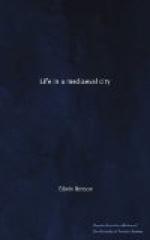In the city there were markets in different places for different kinds of produce on certain days. For instance, in the fifteenth century there was a market of live-stock at Toft Green every Friday. The public squares, called Thursday Market and Pavement, were used as market-places. Some markets were held in the streets. Stalls were set up on which to exhibit the wares. The ordinary foodstuffs and materials, just as in the open market held at the present time in the long and broad Parliament Street, formed of Thursday Market and Pavement and the space formerly occupied by a compact mass of old houses between the two originally distinct squares, were the things sold and bought at the mediaeval markets: such as butter, meat, fish, linen, leather, corn, poultry, herbs. Some, for example butchers’ shops, kept open market every day. Craftsmen worked goods at the premises of their merchant employers, which usually combined the latters’ home and workshop; it was chiefly at the markets and fairs that these goods were sold.
Markets and fairs were controlled by the authority, whether municipal or archiepiscopal, that possessed the right of holding them. Again, particular care was taken to ensure preference being obtained by the citizens over strangers. The Lammas fairs were held under the authority of the Archbishops, who assumed the rule of the city and suburbs for the period of the fair. The sheriffs’ authority, in consequence, was suspended for that period. The Archbishop, meanwhile, took tolls, and all cases that arose during the holding of the fair were judged by a court set up by him.
Fairs combined both trading and entertainments, for they were held on public holidays. They fostered trade and served to provide a change from the ordinary routine of life. It was perhaps at fairs that mediaeval people were at their noisiest, for these were occasions when they gave themselves up unrestrainedly to merry-making, wild and clamorous. Strolling players and the whole variety of mediaeval entertainers set up their stands and booths, and amused the dense surging crowds that thronged the squares and streets.
York had a large overseas trade, especially in wool and manufactured cloth. Some of its merchants owned property abroad. Some went abroad and encountered perils by sea and perils from foreigners on the continent. York traded with the Low Countries, where Veere (near Middleburg) and Dordrecht were ports that ships entered to discharge cargoes loaded on the York quays. The trade between York and the Baltic ports was much greater than that done with them from any other English port.
Foreign sailors were to be seen in the streets of fifteenth-century York; foreign goods were handled in the city. Wines were imported from France, fine cloths from Flemish towns, silks, velvet, and glass from Italy, while from the Baltic came timber and fur. From the North sea came fish, much of which was brought to York from the coast by pack-horse across the moors. The herring was an important article of food.




